Drone Club Takes Off at Arapahoe High School
Drone Club Takes Off at Arapahoe High School
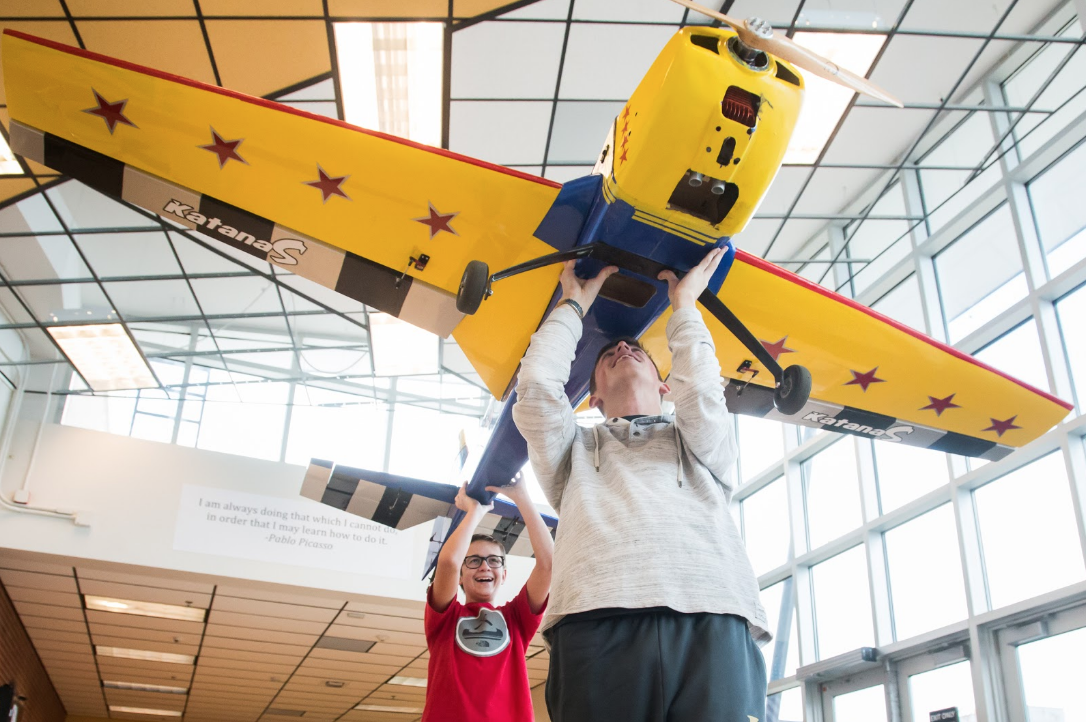
As he hoisted the tail of the large Aeroworks Katana airplane over his head, Blake Vance, a freshman at Arapahoe High School (AHS), laughed and wondered out loud, “How does this thing ever get off the ground if I’m not here to lift it?” Holding much of the plane’s weight above his head, Derek Fernandez, Arapahoe junior and founder of the Drones and Remote Control (DARC) Club, laughed too as he finished a quick landing gear inspection. The sight of the two young pilots holding the big airplane overhead was unusual for the meeting area inside the Study Center at Arapahoe High School - but according to Charlene Brock, the Study Center manager and DARC sponsor, “When they get together with their planes, they always have fun.”
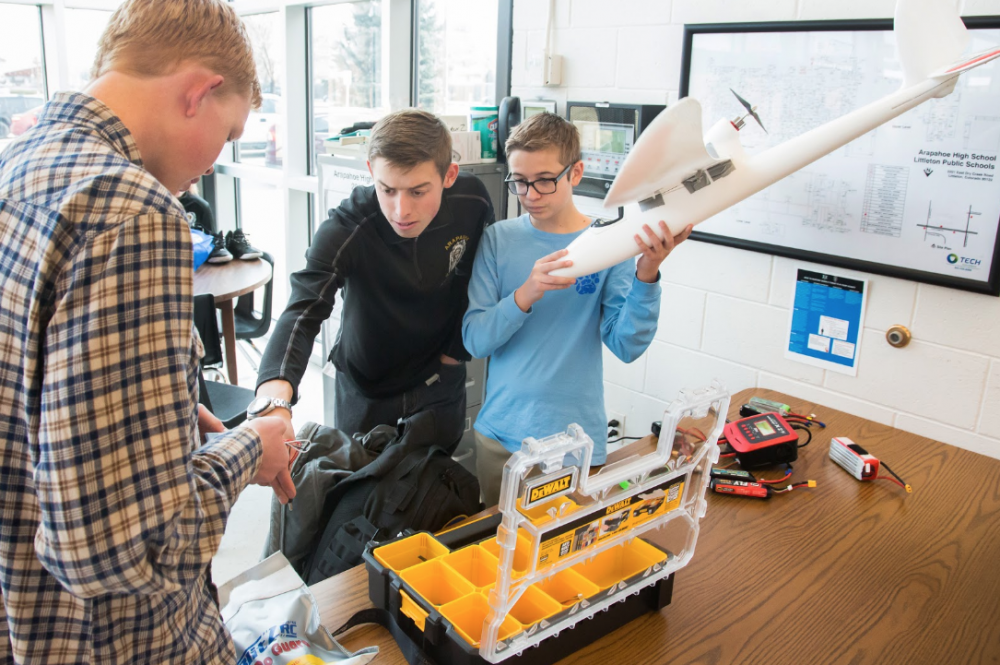
Derek Fernandez (center) oversees pre-flight battery testing as part of the weekly Drone and Remote Control Club that meets at Arapahoe High School. Sam Tucker (left) and Blake Vance (right) look on as Fernandez reviews safe voltage levels for each battery.
With scheduled meetings every week, DARC gatherings typically consist of Fernandez helping to make minor repairs on member planes (not every landing is perfect), followed by a technical lesson and then flight time out on the athletic field. With planes and spare parts tucked under their arms for the five-minute walk to the field, chatter turns to flight conditions (wind direction and speed), prop clearance and pre-flight safety protocols.
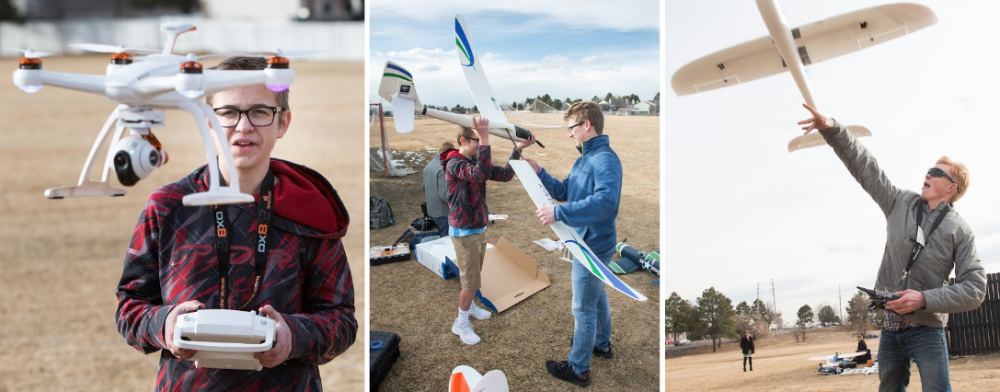
L-R: Blake Vance maneuvers his quadcopter drone; Blake and Johnathon Brooks Jr. assemble a model plane on the flight line; Sam Tucker launches his styrofoam plane from the “tarmac” at Arapahoe High School.
After arriving at the “flight line,” batteries are tested and loaded, minor adjustments are made to ailerons and landing gear, the controllers are readied...and it’s time for takeoff. These aircraft are small enough that they can be hand-launched or taxied out for a runway takeoff - and either method is equally dramatic.
A couple of the planes can fly 40 mph and perform acrobatic maneuvers that would leave even Top Gun’s Maverick feeling queasy. Powered by lithium batteries and controlled by sophisticated digital controllers, these airplanes are governed by the same physics that get a 747 off the ground, just without the noise or the need for a three-mile runway.
Once in the air, the pilots fly their winged aircraft with a speed and grace that is astonishing given their size. Despite a strong breeze, a quadcopter drone rises straight up, then goes zipping around obstacles with crisp precision. The planes climb so quickly that it’s hard to gauge their altitude, and the turns are so smooth that it leaves an observer wondering if there’s anything the planes can’t do in the hands of these young pilots.
Fernandez, an AHS junior, started the club last semester to create a space for pilots to share their aero-modeling passion and expand their knowledge of the hobby. “Basically, I wanted to ‘fly things with friends’ and to let anyone who does this for a hobby have some fun with us,” said Fernandez. “And if I can teach them to become better pilots along the way, then that’s a bonus.”
That ‘bonus’ could be jobs. As the remote control aircraft/drone industry quickly expands, there is a growing need for licensed drone pilots. The Federal Aviation Administration (FAA) is expecting that there will be 7 million drones in the U.S. by 2020, with 2.7 million of those being used commercially. Forty-two percent of commercial drones will end up in industrial inspection, 19 percent in agriculture, 15 percent in insurance, 22 percent in real estate or aerial photography and two percent in government. That is a big job market waiting to be filled. But there is a catch - to fly a drone commercially, a pilot must have an FAA Rule 107 license - and they are difficult to get.
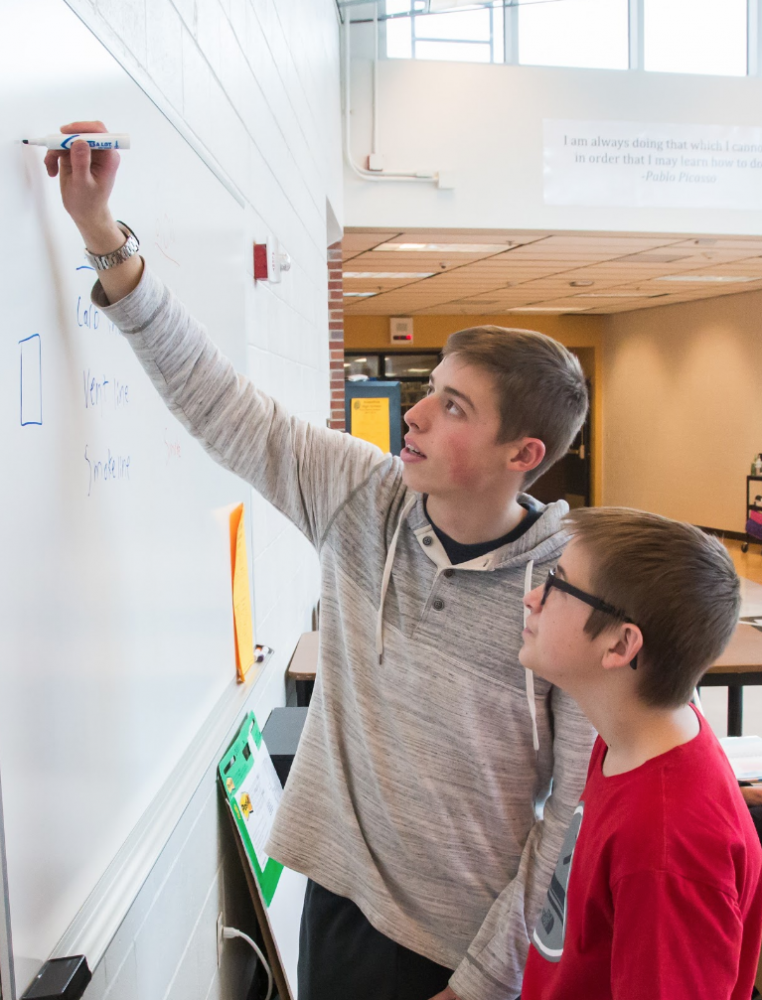
Derek Fernandez illustrates the fuel flow characteristics of a gas-powered model plane for Blake Vance during a classroom session of the Drone and Remote Control club at Arapahoe High School. Fernandez is hoping that his knowledge and experience will help the other club members pass the Rule 107 test and become certified drone pilots.
Preparing for the Rule 107 test is a demanding task, with an 87-page study guide from the FAA as a starting point. The 60 question test covers topics like aviation acronyms, rules for U.S. airspace, the physics of weather and flying, Morse code and a section on how to actually fly a drone. A score of 70% or above is required to pass; anything below is considered failing. Because of the test’s difficulty and a growing demand for licensure, there is a growing market for test prep schools in the Denver metro area, with some charging as much as $1700 to take a student through the Rule 107 testing process and flight school.
Fernandez is offering to teach and prepare his club members to get their Rule 107 license - free of charge. With his Rule 107 license in hand (as well as a private pilot’s license with a commercial rating for “big” planes - he started flying at age 4) he wants all of the club members to get their 107 licensure so they can have opportunities in the growing drone aviation field. With part of each meeting devoted to preparing for the test, Fernandez shares his experience and knowledge to help create a new generation of pilots from his peers.
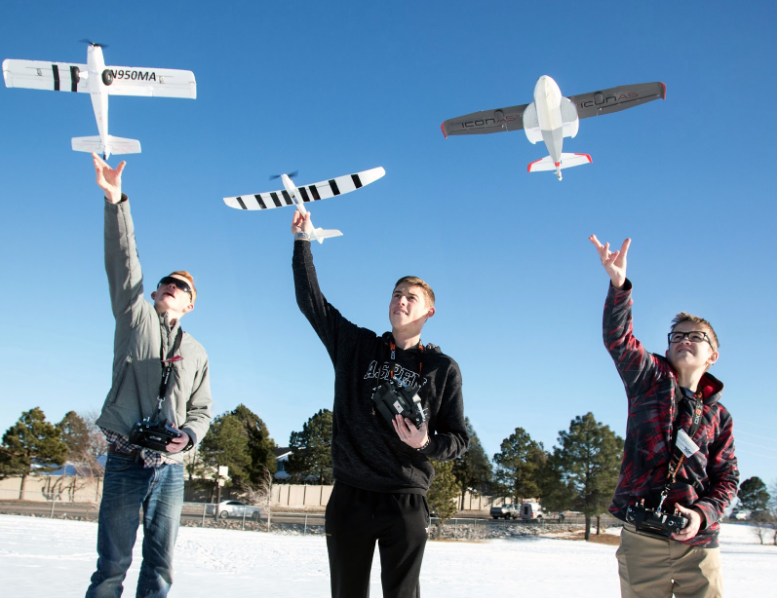
L-R: AHS students Sam Tucker, Derek Fernandez and Blake Vance hand-launch their smaller planes during a Drone and Remote Control Club gathering on the athletic field north of Arapahoe High School.
“I will admit that I joined the club to have fun, be with friends and learn,” said Sam Tucker, AHS freshman. “I want to get my 107 so I can fly in a wider set of circumstances and make some money. I started prepping for the test two years ago and it was too hard - but our drone club makes it easier to apply what I’ve learned, and Derek’s experience with the test will definitely help me.”
Johnathan Brooks, AHS junior, was involved with the Civil Air Patrol (CAP) before joining the club and felt that this group would be a good fit for his flying interests. “The model flying is terrific - it’s amazing what you can do with your aircraft without putting yourself in any danger. I’d like to get a pilot’s license for my CAP work, but connecting with people is just as important to me - I couldn’t ask for a better group of friends.”
Amidst all the fun and learning, DARC members have a weekly outlet for their passion - flying. “I’ve always wanted to be a pilot - ever since I was really young,” said Blake, as he lowered the big yellow Katana back to the ground. “The coolest part of this club is being able to build stuff and fly it. Flying with your friends is awesome and I’m proud to have it as part of my school.” With that support and Fernandez’s leadership, club members are building their confidence and skills, all while getting an early foothold in the expanding unmanned-aircraft industry.
Featured Image: Blake Vance (l) and Derek Fernandez (r) easily lift an Aeroworks Katana model plane over their heads for a pre-flight inspection. Sporting a wing span of more than 6’ and a gas-powered engine, this flying giant made a rare appearance at a recent Drone and Remote Control club at Arapahoe High School.
